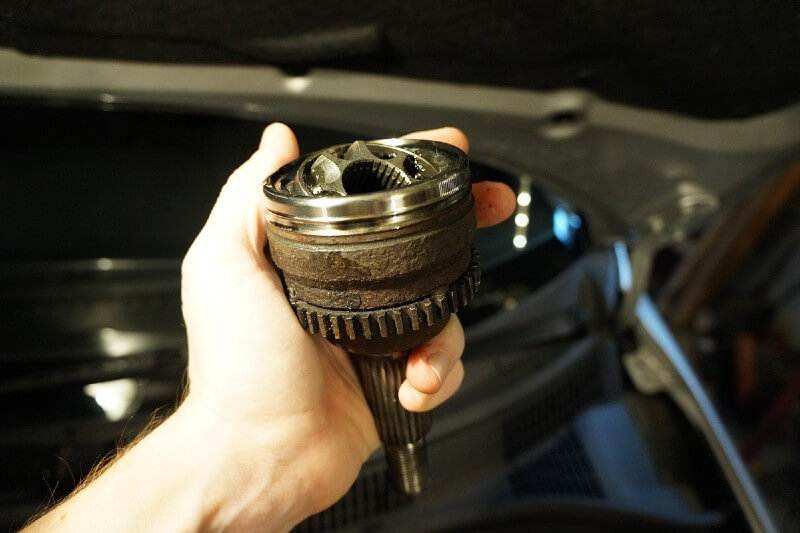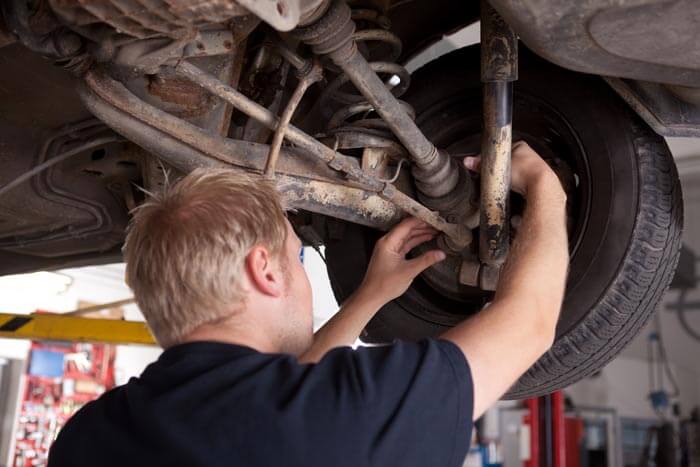CV joint stands for constant velocity joint and they are primarily used in front-wheel drive vehicles while some rear-wheel-drive vehicles typically use them at the end of rear axle half shafts. It is a form of mechanical coupling in which the rotational speed of input and output shaft remains the same no matter what the operating angle of the joint is.
The axle or drive shaft in the vehicles is required to accomplish two jobs:
- Be able to transmit power to the wheels.
- Travel with the suspension as it cushions the bumps.
This gets even complicated in case of front-wheel drive vehicles where articulation angles are higher because of steerable wheels. With a wide range of variable angles by suspension travel and wheel steering, the axle has to act flexibly. Hence the vehicle employs inboard and outboard CV joint to permit the effective length of the side shaft to change simultaneously allowing torque transfer through a wide-angle. In rear-wheel-drive applications, operating angles are much lower.
CV Joint Issues

A CV joint is a collection of many components (bearings, race, cage, housing, and balls) connected all together in a precisely fitted assembly. All the parts spin around in a protective layer of special grease which is held inside the joint assembly. The assembly is packed and sealed tight with flexile rubber boot held in place by clamps and prevents the grease from coming out of the CV joint. The boot also keeps the joint safe from outside contamination and keeps dirt and grime out. A CV joint doesn’t require maintenance and can perform very long if the rubber boot is not damaged. Over time, rubber boots fail from age or can become cracked, torn by road debris.
The most common problem with the CV joint is damaged boots. Once the boots get damaged, grease makes it’s way out and moisture and dirt get into a CV joint assembly. This will ruin the CV joint by causing it to wear out faster and fail eventually. Outer CV joints boots fail earlier than inner ones as they have to endure more strains due to more angles.
Signs Of A Failing CV Joint

CV joints may fail as a result of a lack of lubrication or contamination. In extreme cases, a badly worn CV joint can disintegrate while driving leaving a vehicle un-drivable. A CV joint that is has worn out-produces following symptoms:
Loud Clicking Or Popping Noise While Turning
This almost always points out to a worn outer CV joint. To verify this, crank the steering wheel to one side and drive around in circles either backward or frontwards. Noise getting louder confirms the diagnosis and necessitates the replacement of the CV joint or shaft assembly.
A Crackling Or Clunking Upon Acceleration And Deceleration
This indicates excessive play in the inner CV joint in front-wheel drive vehicles. In rear-wheel drive or all-wheel drive vehicles, this symptom translates into excess play in either inner or outer CV joints, or into driveshaft CV joint or Universal joints. Though, similar noise can occur as a result of excessive backlash in differential gears. A worn inner CV joint may produce clunk while shifting from drive to reverse. To confirm, drive the vehicle backward alternately accelerating and decelerating. If the noise gets more pronounced, it confirms the possibility of a ruined inner joint.
A Vibration Or Shudder During Acceleration
Most Probable cause of this is worn inboard plunge joint through Excessive play in the inboard or outboard joint can often be the reason for this. Faulty intermediate shaft bearing on transaxle with equal-length half shaft can also produce these sorts of vibrations. These kinds of vibrations can also occur as a result of loose or deteriorated engine mounts.
A Vibration Which Increases With Speed
This often indicates a failing CV joint imbalance half shaft in front-wheel drive vehicles. An unbalanced wheel, and out of around tire or bent rim also translates into this symptom.
CV Joint Inspection

One of the very first inspections that should be done is the boots around all four CV joints on a front-wheel-drive vehicle. The boots should be examined for cracks, splits, punctures, tears, abrasion damage, and loose or missing clamps. If a damaged CV joint boot is caught early enough, it is possible to save the joint. Boot damage always indicates uncertainty about the condition of joint whether or not it has become contaminated or suffered wear. If the CV joint has started making noise, certainly, the damage has already been done and the joint needs to be replaced.
What If CV Joint Has Damaged Boot But No Noise?
In such a condition, the joint should be examined thoroughly. Grease inside the joint should be inspected whether or not it feels ‘gritty’ while rubbing between the fingers. If it does feel gritty, it indicates that the grease and joint are contaminated. Joint needs to be cleaned and grease needs to be replaced. If joint doesn’t show any sign of wear or any other damage, simply cleaning the joint and repacking with fresh grease and replacing the boot is all that is usually required. This is much cheaper than replacing the whole CV joint.
Examining a CV joint and replacing a boot involves removal and disassembling. The boot itself doesn’t cost much but a fair amount of labor is involved in the process.
How Important Is CV Joint Service?
CV joints on the axle shafts connect the transmission to wheels. As you step on the gas pedal, transmission gears turn the axle shaft through CV joint, axle shaft then turn the wheels again through the CV joint. Faulty CV joints will not rotate correctly leading to inaccurate transmission of power from the gearbox to wheels. Driving with defective CV joint leaves your vehicle at risk. In severe cases, a bad CV joint may disintegrate before any warning. This will leave your vehicle stranded. Therefore, to avoid such kind of situation, perform a CV joints inspection!

